Wurst 精选 5 - 三月下旬更新
更新于 2018年11月29日

1.29 和 PTR
Wurst 团队对新的 PTR 变更将为 wc3 modding 社区带来什么感到兴奋和好奇。我们期待着在稳定的战网服务器上发布,并将尽快为 Wurst 工具链添加支持。
目前,我们不打算设立一个单独的分支来支持 PTR 安装。然而,如果经典团队继续广泛使用测试服务器,我们将来可能会考虑这个选项。
我们正在积极思考 PTR 的变更对我们意味着什么,以及它将如何影响 2018 年的时间线。例如,既然 24 人地图即将到来,我们将优先支持从 VSCode 编辑地图玩家元数据。
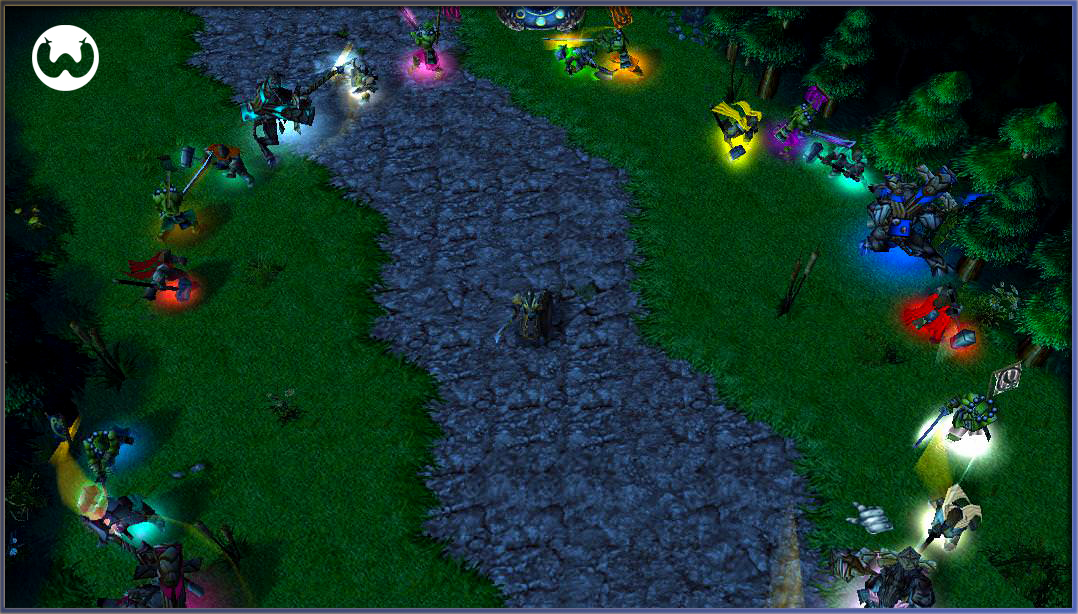
上图:在 Wurst 中实现的 24 种独特的玩家颜色!
更新
我们本月的博客文章发布得有点晚,因为没有重大的更新要介绍,而且我们一直专注于高质量的工作以及关注 Wurst 的稳定性。话虽如此,在三月份,我们改进了 lambda 语法,以获得更大的灵活性和更简洁的代码。此外,我们再次收到了来自社区的一些贡献。
- 针对 lambda 表达式和闭包的类型推断以及新的代码块处理
- 我们为标准库解决了一些已开启的问题 (#44, #45, #48) 并合并了 7 个拉取请求 (#47, #49, #50, #51, #51, #54, #55, #56)。
- Wurst Setup 获得了一些稳定性更新,我们正在努力将其与 Wurst 工具套件进一步集成。
注意:我们仍在为我们的展示页面寻找 Wurst 资源!
Lambda 的新玩法
现在编写 lambda 表达式时,类型是可选的:
interface UnitFunction
function run(unit u)
function group.foreach(UnitFunction closure)
...
// Before:
g.foreach((unit u) -> print(u.getName()))
// Now also possible:
g.foreach(u -> print(u.getName()))
// Works for multiple params too:
list.foldl((x, y) -> x + y)
此外,如果 lambda 是当前行的最后一个参数,你现在可以去掉语句 lambda 的 begin 和 end 关键字。lambda 会被移动到函数调用之后,像这样:
// Before:
doAfter(10.0, () -> begin
u.kill()
createNiceExplosion()
doMoreStuff()
end)
// Now also possible:
doAfter(10.0) ->
u.kill()
createNiceExplosion()
doMoreStuff()
使用新语法,缩进定义了代码块。这允许人们定义自定义的控制流,看起来非常像语言内置的结构。
begin 和 end 语法当然会保留,以实现向后兼容,并用于 lambda 不是最后一个参数的情况。
Wurst 法术探秘
在 wc3 中,法术是一个非常流行的脚本编写选择,大多数地图至少有一些脚本化的技能。
在这里,我们将展示一个简洁的例子,说明如何结合物体编辑、事件监听和闭包的使用,轻松创建一个不错的法术。
在这个例子中,我们正在制作一个名为“Conflagration”(大火)的定时爆炸法术。爆炸会对击中的敌人施加一个燃烧的减益效果,这会使后续的“Conflagration”命中造成额外伤害。我们的目标是使该法术易于配置,并最终将其上传到 GitHub,以便可以轻松地导入到 Wurst 项目中。
配置包
要制作一个易于配置的法术,有时先考虑配置包会很有帮助。根据概念,我们知道我们希望允许用户以何种方式自定义技能,例如:
- 基础伤害,额外伤害
- 法术半径、效果、持续时间
- 增益效果持续时间、效果
为了将其转化为 Wurst 代码,我们用列表中的变量创建一个新的包。为了让用户可以配置它们,我们必须用 @configurable 对它们进行注解。
package ConflagrationConstants
import public Assets
@configurable public let BASE_DAMAGE = 50.
@configurable public let BONUS_DAMAGE = 50.
@configurable public let SPELL_EFFECT_PATH = Units.infernalBirth
@configurable public let BONUS_EFFECT_PATH = Abilities.fireBallMissile
@configurable public let SPELL_EFFECT_DURATION = .75
@configurable public let SPELL_RADIUS = 256.
@configurable public let SPELL_ICON = Icons.bTNBreathOfFire
@configurable public let SPELL_NAME = "Conflagration"
@configurable public let SPELL_TT_NORMAL = "Cast Conflagration"
@configurable public let SPELL_TT_EXTENDED = "Conjures a firey explosion at the " +
"target, damaging nearby enemies and applying a buff, which will cause them to " +
"take more damage on succeeding hits of this spell."
@configurable public let BUFF_DURATION = 7.5
@configurable public let BUFF_EFFECT_PATH = Abilities.incinerateBuff
@configurable public let BUFF_NAME = "Conflagrated"
@configurable public let BUFF_TT = "This unit has weakness to fire"
显然,以上代码描绘了一个伤害和持续时间都相当低的快速、单位型法术的蓝图。
法术物体
接下来,我们将为我们的法术生成所需的物体。我们需要一个技能物体给使用该法术的单位,以及一个增益效果物体,用于在视觉上和状态上显示“Conflagration”的存在。
因此,我们创建一个新的包
package ConflagrationObjects
import public ConflagrationConstants
import public BuffObjEditing
import ChannelAbilityPreset
public let SPELL_ID = compiletime(ABIL_ID_GEN.next())
public let BUFF_OBJ = compiletime(createDummyBuffObject(BUFF_NAME, BUFF_TT, Icons.bTNFireBolt, Abilities.incinerateBuff, "chest"))
@compiletime function genObj()
new ChannelAbilityPreset(SPELL_ID, 4, true)
..setName(SPELL_NAME)
..presetTooltipNormal(lvl -> SPELL_TT_NORMAL)
..presetTooltipNormalExtended(lvl -> SPELL_TT_EXTENDED)
..presetIcon(SPELL_ICON)
..presetButtonPosNormal(0, 0)
..presetManaCost(lvl -> 0)
..presetCooldown(lvl -> 4.)
..presetHotkey("Q")
..presetTargetTypes(Targettype.POINT)
..presetAreaofEffect(lvl -> SPELL_RADIUS)
..presetOption(Option.TARGETIMAGE, true)
法术效果
最后,我们创建实际的效果。在地图初始化时,我们注册一个法术事件监听器,当任何单位施放我们生成的法术时,它将被触发。
package Conflagration
import ConflagrationObjects
import ClosureTimers
import ClosureForGroups
import HashMap
import ClosureEvents
let buffId = BUFF_OBJ.abilId
let buffMap = new HashMap<unit, CallbackSingle>()
init
EventListener.onPointCast(SPELL_ID) (caster, tpos) ->
flashEffect(SPELL_EFFECT_PATH, tpos)
doAfter(SPELL_EFFECT_DURATION) ->
forUnitsInRange(tpos, SPELL_RADIUS) u ->
if u.hasAbility(buffId)
caster.damageTarget(u, BONUS_DAMAGE)
flashEffect(BONUS_EFFECT_PATH, tpos)
caster.damageTarget(u, BASE_DAMAGE)
u.addAbility(buffId)
if buffMap.has(u)
destroy buffMap.get(u)
let cb = doAfter(BUFF_DURATION) ->
if buffMap.has(u)
buffMap.remove(u)
u.removeAbility(buffId)
buffMap.put(u, cb)
我们使用来自 ClosureEvents.wurst 的 EventListener.onPointCast 来监听 SPELL_ID 的施法事件。当一个具有正确 ID 的 SPELL_EFFECT 事件发生时,下面缩进的代码块将被执行。lambda 参数 (caster, tpos) 将被适当地填充为施法单位和目标点。
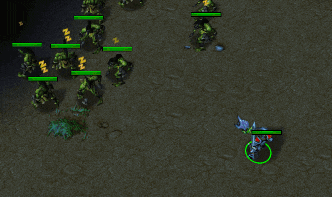
法术实际效果
为我们的项目创建仓库
最后,让我们从我们的 Wurst 项目创建一个 git 依赖。我们将使用 GitHub 及其对应的桌面应用,这需要一个免费账户。如果你还没有,请创建一个账户并设置好该应用。
一旦你设置好了应用,我们就可以通过选择 File -> Add Local Repository 在我们的项目文件夹内创建一个新的 git 仓库。选择你项目的根目录,然后选择 create a repository:
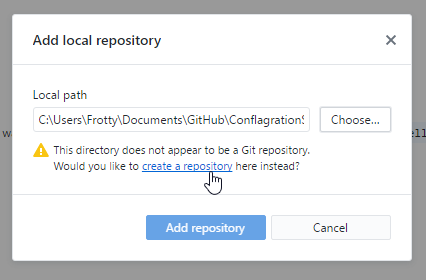
保持所有设置不变并创建仓库:
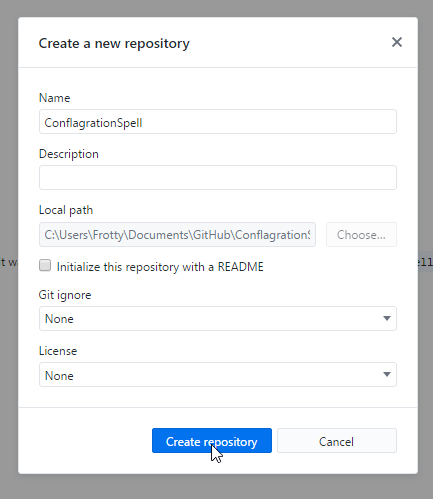
太棒了,我们的仓库已经创建好了。我们所有现有的文件都已添加到一个初始提交中。不应被版本控制的文件会被设置工具生成的配置自动忽略。现在我们可以发布我们的仓库了:
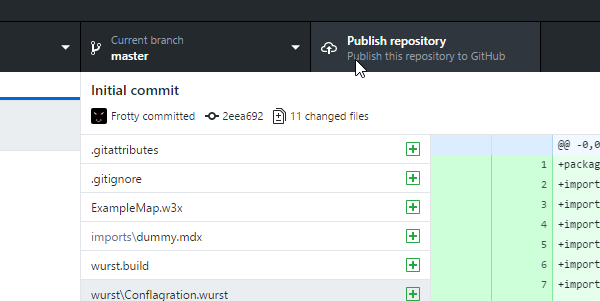
如果一切顺利,你的仓库现在已经发布了。你可以在这里查看我们在这篇博客文章中创建的仓库:https://github.com/Frotty/ConflagrationSpell
注意 如果你想了解更多关于 git 工作流程的信息,可以在线查看一些教程,比如这个。
使用仓库作为 Wurst 依赖
打开设置工具并导入某个其他项目的 wurst.build 文件。在 Advanced 下,你现在可以输入我们上面创建的仓库链接。点击 Update Project 来更新依赖项。


重新加载 VSCode,你应该就能够按需导入该法术了。
就是这样!感谢阅读又一篇 Wurst 精选博客。
此致 Frotty & Cokemonkey11